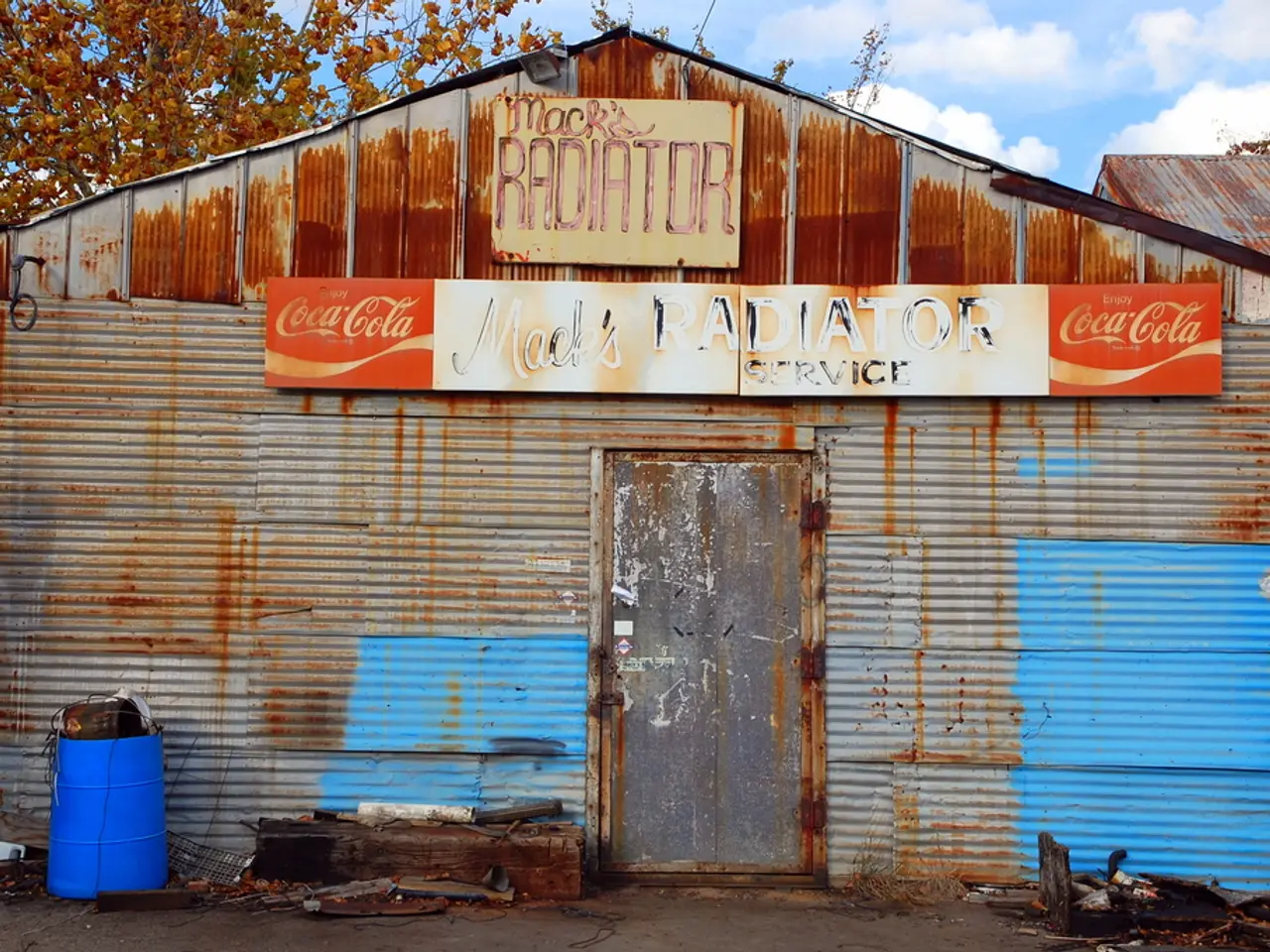Toxic Substance Removal: Safety-Kleen Envirosystems Corporation in Newark, New Jersey Carries Out Hazardous Waste Purge
The Safety-Kleen Envirosystems Company site in Newark, New Jersey, located at 600 Doremus Avenue, has a long history of contamination due to past industrial activities. This 9.5-acre site, also known by several names such as Balbach Smelting and Refining Corporation Works, Kolker Chemical Co, Inland Chemical Corp., and McKesson Envirosystems Co., has been identified as a Superfund site, primarily contaminated with hazardous waste such as solvents and heavy metals.
In the past, the site has experienced significant groundwater contamination, with chlorinated VOCs from Safety-Kleen migrating to the adjacent Cardolite property and the Passaic River/Newark Bay. Remedial measures for soils and groundwater were implemented in the 1990s and 2000s.
To manage the contamination, several Institutional Controls and Engineering Controls have been put in place. The Institutional Controls include a Deed Notice and a Classification Exception Area (CEA), which restrict the use of groundwater and soils as long as they remain contaminated. The Engineering Controls, on the other hand, include an asphalt cap, a perimeter chain-link fence, a locking gate, and a low-permeability vertical subsurface barrier wall, all aimed at preventing human exposure to remaining impacted soils and minimizing infiltration of surface water.
Key milestones in the remediation process include the completion of a Remedy Completion Completed (CA 550) on March 10, 2011, a Vapor Intrusion (VI) sampling on February 25 and 26, 2016, due to the presence of groundwater impacts at the Safety-Kleen site, and a Ready for Anticipated Used (RAU) (CA800) on July 8, 2016.
The final remedies, consisting of Monitored Natural Attenuation (MNA) and Institutional Controls, were outlined in a remedial action work plan (RAWP) in June 2010. The final remedies were public noticed on November 9, 2010, and approved by the New Jersey Department of Environmental Protection (NJDEP) on December 15, 2010.
Current operation, monitoring, and maintenance activities are being performed under a Deed Notice dated April 8, 2005, a Soil Remedial Action Permit dated May 2, 2011, and a Groundwater Remedial Action Permit dated January, 2014.
However, for precise, up-to-date details—including current contamination status, cleanup milestones, and enforcement of institutional controls—it is recommended to consult authoritative sources such as the U.S. Environmental Protection Agency (EPA) Superfund Site profile for Safety-Kleen Newark, NJDEP records, or recent environmental remediation reports or public notices from local government agencies.
As of now, the site's soil and groundwater continue to be contaminated with polychlorinated biphenyls and volatile and semi-volatile organics. Groundwater monitoring will continue to verify that monitored natural attenuation processes are continuing to reduce chlorinated VOC concentrations.
For more information or updates on the Safety-Kleen Envirosystems site, it is advisable to contact the NJDEP or the EPA directly.
- The contaminated land at 600 Doremus Avenue, Newark, New Jersey, bears previous names like Balbach Smelting and Refining Corporation Works, Kolker Chemical Co, Inland Chemical Corp., and McKesson Envirosystems Co.
- The Superfund site, formerly held by Safety-Kleen, is primarily contaminated with hazardous waste such as solvents and heavy metals.
- The site's groundwater has been contaminated significantly due to the migration of chlorinated VOCs from Safety-Kleen.
- In the past, groundwater contamination extended to the adjacent Cardolite property and the Passaic River/Newark Bay.
- Remedial measures for soils and groundwater were implemented in the 1990s and 2000s at the Safety-Kleen site.
- Institutional Controls, including a Deed Notice and a Classification Exception Area (CEA), have been set in place to restrict the use of groundwater and soils.
- Engineering Controls, like an asphalt cap, a perimeter chain-link fence, a locking gate, and a low-permeability vertical subsurface barrier wall, aim to prevent human exposure to impacted soils and minimize surface water infiltration.
- The final remedies, consisting of Monitored Natural Attenuation (MNA) and Institutional Controls, were outlined in a remedial action work plan (RAWP) in June 2010.
- The final remedies were public noticed on November 9, 2010, and approved by the New Jersey Department of Environmental Protection (NJDEP) on December 15, 2010.
- Current operation, monitoring, and maintenance activities are being performed under permits issued in 2005, 2011, and 2014.
- Precise, up-to-date details about the site can be found in EPA Superfund Site profiles, NJDEP records, or recent environmental remediation reports.
- As of now, the site's soil and groundwater continue to be contaminated with polychlorinated biphenyls and volatile and semi-volatile organics.
- Groundwater monitoring continues to verify that monitored natural attenuation processes are reducing chlorinated VOC concentrations.
- For more information or updates on the Safety-Kleen Envirosystems site, contact the NJDEP or the EPA directly.
- The oil-and-gas industry often faces environmental issues related to waste and chemicals, requiring cleanup efforts.
- Science plays a crucial role in determining the extent and nature of contamination and developing appropriate remediation strategies.
- finance plays a significant role in funding these cleanup efforts, especially in the environmental-science sector.
- Energy companies should prioritize using sustainable, low-impact technologies to minimize their environmental footprint.
- The fashion-and-beauty industry contributes to pollution through waste and chemicals, but companies can take steps to reduce their impact.
- Consumers can make eco-friendly choices in food-and-drink products to support sustainable agriculture and reduce pollution.
- Investing wisely in businesses with strong environmental practices helps protect personal-finance and the environment.
- Real-estate developers must consider the environmental impact of their projects, including contaminated land.
- data-and-cloud-computing can aid in the analysis and monitoring of waste and pollution.
- Technology advancements can help in the detection, analysis, and remediation of environmental contaminants.
- Relationships, both personal and professional, should prioritize sustainability and environmental responsibility.
- Properly caring for pets involves being aware of and minimizing their impact on the environment.
- Travel choices can have a significant impact on the environment; consider eco-friendly options.
- Choosing a fuel-efficient car reduces the emissions and impact on water resources.
- Reading books on environmental science and self-development can inspire personal growth and a greater understanding of the environment.
- Online education and self-development resources can provide valuable insights into environmental issues and sustainable solutions.




